9 Japandi bedroom ideas to create a serene and stylish scheme
Discover how to create a beautiful sleek and soothing Japandi bedroom with these beautiful decorating ideas and expert advice

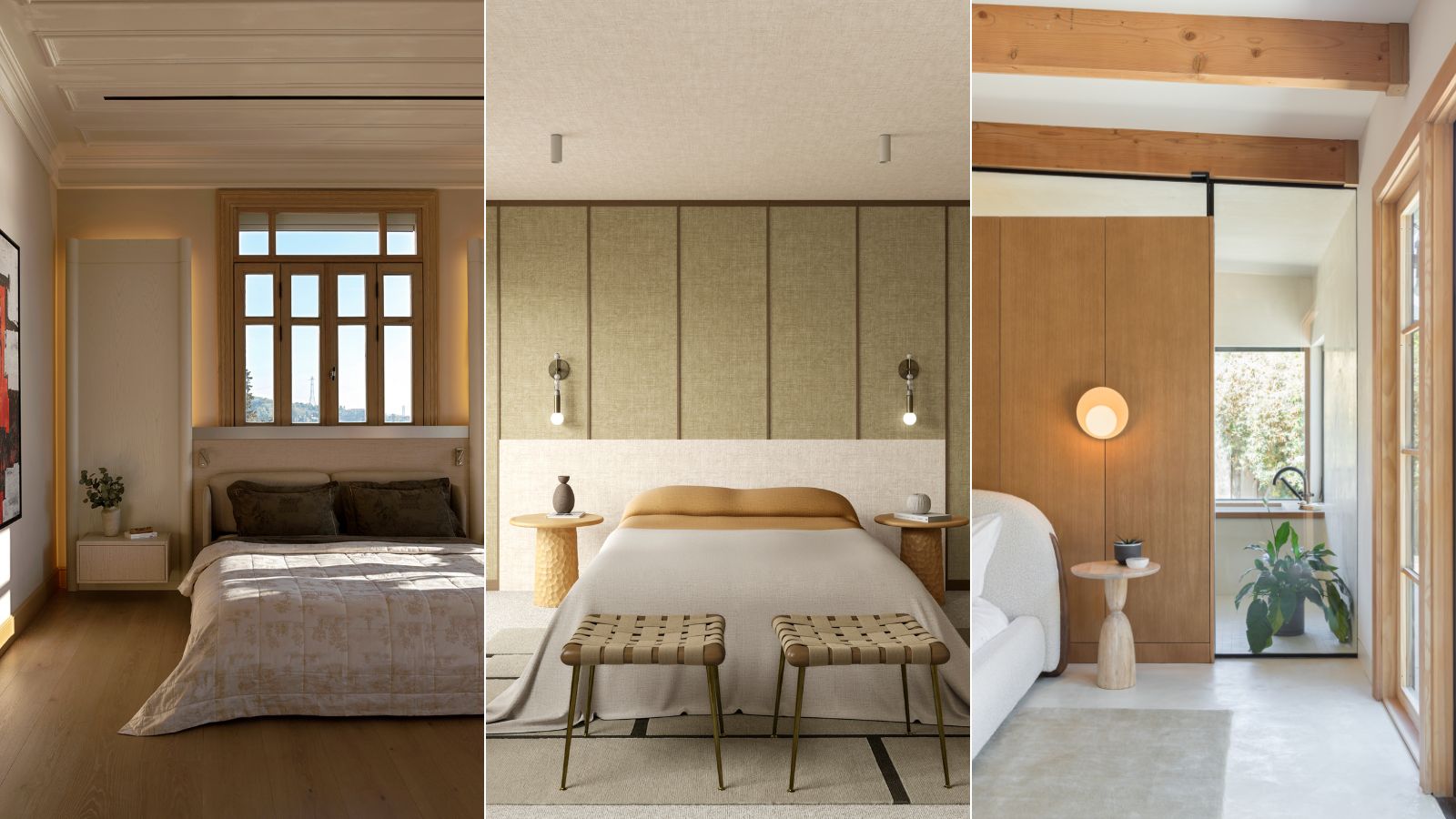
We’re seeing a growing trend for Japandi bedrooms at the moment and it’s easy to see why. A combination of Japanese and Scandinavian influences, the Japandi style is perfectly suited to soothing spaces like bedrooms. With a focus on pared-back minimalist style, sleek lines and natural materials, the look has timeless appeal and works in an array of rooms and properties.
If you’re looking to create a bedroom that will soothe the soul and enhance well-being then a Japandi scheme may well be for you. Here we’ve gathered an array of beautiful and serene bedroom schemes and advice from interior designers to inspire your project.
What is Japandi style?
Japandi style is a fusion of Japanese minimalism and Scandinavian simplicity resulting in pared-back, functional and calm spaces characterised by sleek lines, soothing neutral tones and organic materials. While Japandi is a bit of a buzzword at the moment, the look is nothing new and taps into age-old principles that interiors can promote wellbeing.
Underlying Japandi decor is a strong desire to integrate nature into interiors combined with a deep appreciation for craftsmanship, both of which play a role in Japanese and Scandinavian decor.
‘The most important similarity is nature. In both Japan and Scandinavia, they love to spend time in nature and bring nature into their home. This resonates not only by using natural materials like wood and linen but also with organic shapes’, says Laila Rietbergen, creator behind the popular Instagram account @japandi.interior and author of Japandi Living.
'Where in Japanese interiors you will find darker colors and wood, in Scandinavian design you will find more light wood and soft and brighter pops of color. This combined makes an interesting space with different use of natural materials, different kinds of (round/organic) shapes and contrast', adds Laila Rietbergen.
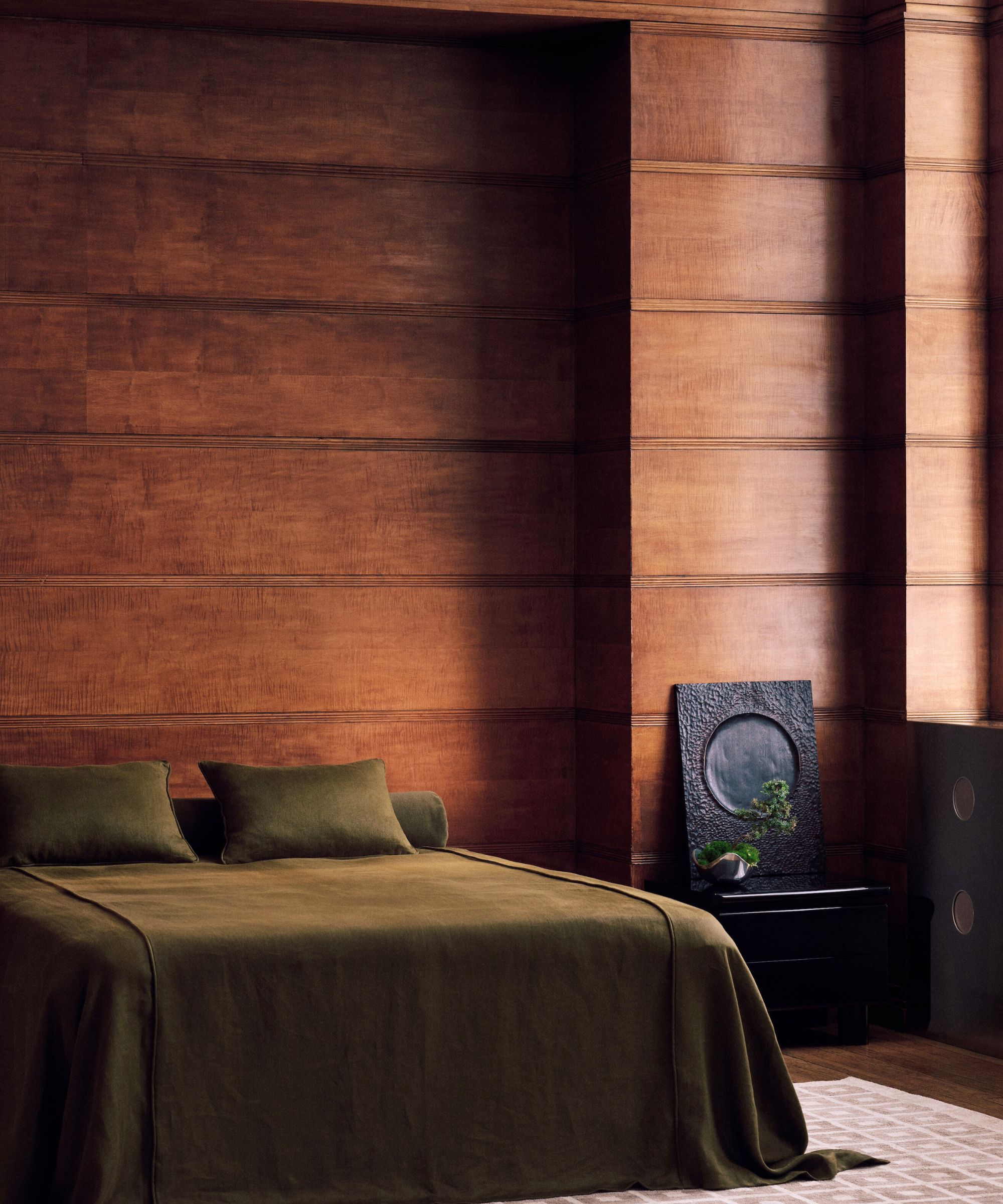
How can you create a Japandi bedroom?
To embrace the Japandi look in a bedroom choose subtle tones drawn from nature alongside natural materials. Soothing and light, warm neutrals as well as the blues and greens of nature make a fitting backdrop for plenty of layered textures such as wood, rattan, grasscloth and linen.
Design expertise in your inbox – from inspiring decorating ideas and beautiful celebrity homes to practical gardening advice and shopping round-ups.
At the heart of a Japandi bedroom are well-made, simple yet functional furnishings. Streamlined surfaces and integrated storage solutions teamed with discreet, low-profile beds and side tables help set the tone for clean, sleek and minimalist spaces.
'Also the common love for craftsmanship is found in Japandi style interiors. For example, handmade wooden items and ceramics that are made to last. A really Japandi-specific aspect is that most decor is functional, think of books, teapots and other ceramics,' adds Laila Rietbergen.
Below we've rounded up an array of calming Japandi schemes to get you inspired, alongside some more tips from interior designers on how to create a Japandi bedroom.
1. Embrace the beauty of wood
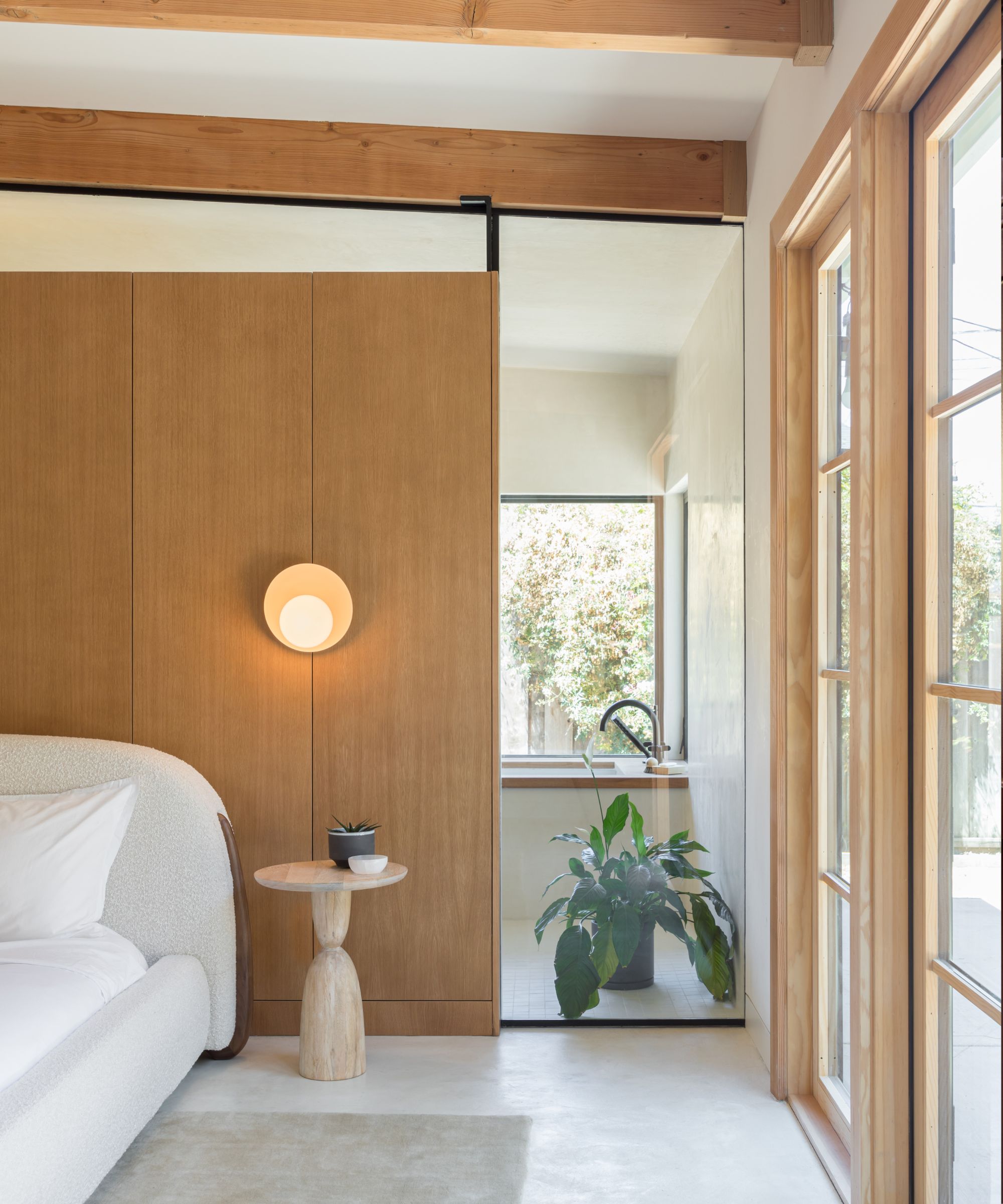
At the heart of the Japandi look is a desire to connect interiors with nature and immersing a space in beautiful natural timber is a wonderful way to create that soothing, forest bathing feel. In this bedroom by Rae & Heath Architects, integrated oak millwork is the standout feature. As well as creating a warm and organic backdrop to the space the wood also conceals ample storage which allows the bedroom to remain clutter-free and calming. After all, there’s nothing better than a clear space for a clear mind.
'Fully integrated bedroom storage is the key to achieving the calming, retreat-like feel of this minimalist primary suite remodel. Warm oak panels wrap around the bedroom so that the bed wall effortlessly transforms into generous custom closets. This L-shaped millwork feature is the defining element that grounds the bedroom while allowing the ceiling above to float through to the bathroom for an airy, light-filled space,’ says Megan Rae Hannon, principal designer at Rae & Heath Architects.
‘Integrated within the millwork is a pair of hidden doors leading to the bathroom as well as shelving to store and display treasured items. In order to keep the lines of the room as clean and zen as possible, the furniture in the room is limited to just the bed and carved wood nightstands.'
While natural materials are a hallmark of Japandi style, the aesthetic isn’t to be confused with rustic country style. Rather than pieces made from chunky and rustic materials, choose furnishings that are textured yet refined and that embrace sleek, contemporary design.
2. Introduce tactile, organic textures
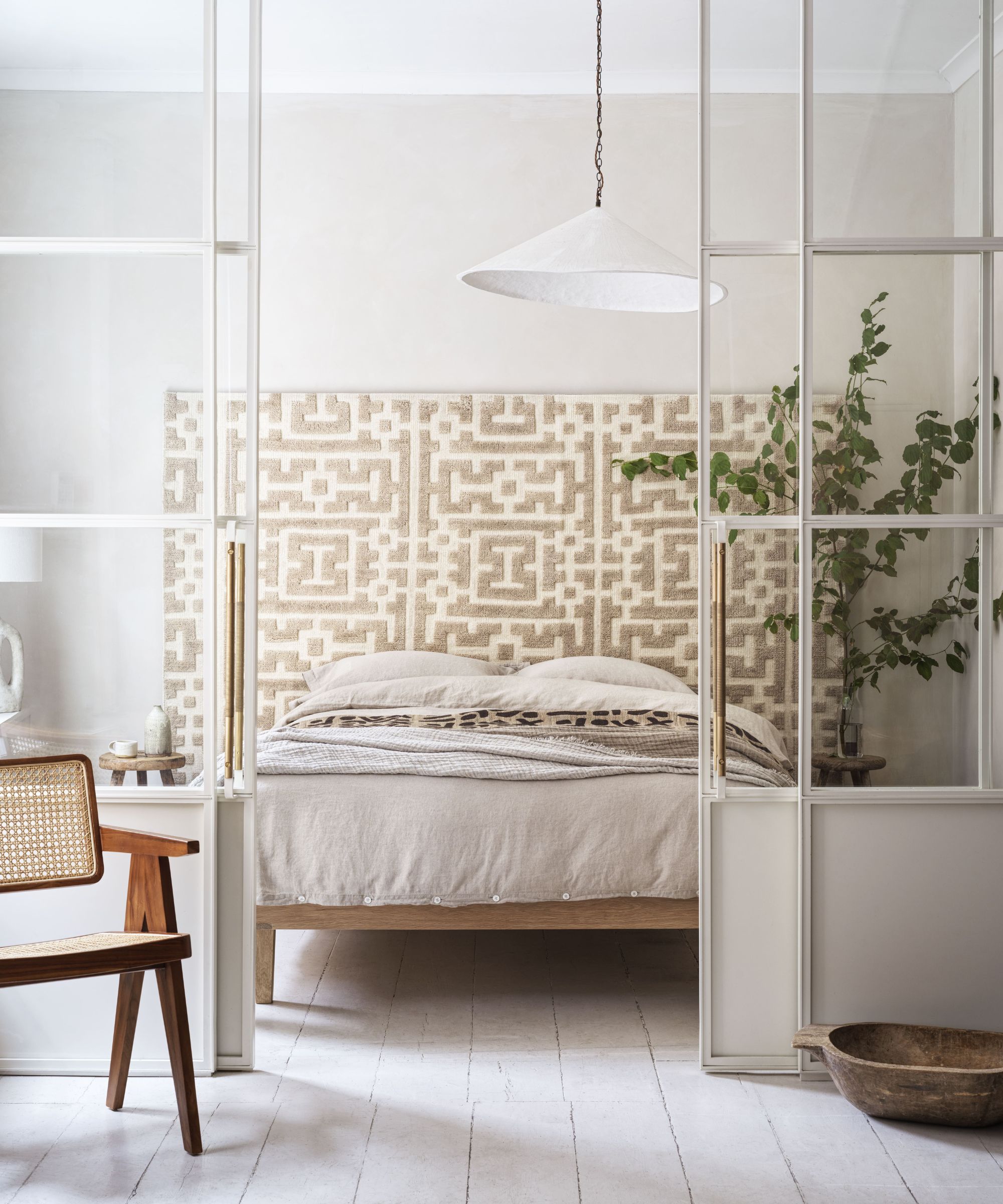
Decorating with neutrals is a hallmark of the Japandi look. Whether dark or light, pared-back schemes of warm neutrals help spaces feel serene, however, if you’re going for a neutral bedroom it’s important to factor in plenty of organic and tactile textures to ensure the space feels welcoming and cozy. This statement bed from Naturalmat with its geometric headboard brings much-needed texture to this neutral space but also provides a welcome dose of pattern without overwhelming the scheme.
'Japandi design perfectly balances the relaxed and minimalist feel of Scandinavian style and the sophistication of Japanese interiors. The use of texture has become synonymous with Japandi, particularly the use of natural finishes, which can easily be incorporated into the home. A soft off-white palette creates a perfect base to build upon and allows the natural light to bounce off the walls for an airy and serene setting,’ says Mark Tremlett, founder of Naturalmat.
‘Tapestry is an easy way to add subtle texture, depth, and interest to the walls while embracing the delicate details of Japandi design. It’s a great addition to the bedroom in replacement of a headboard as it creates a focal point and adds height to the room. It works especially well in rooms to add character and interest when architectural features might be minimal.’ adds Mark Tremlett.
3. Choose a pared-back palette
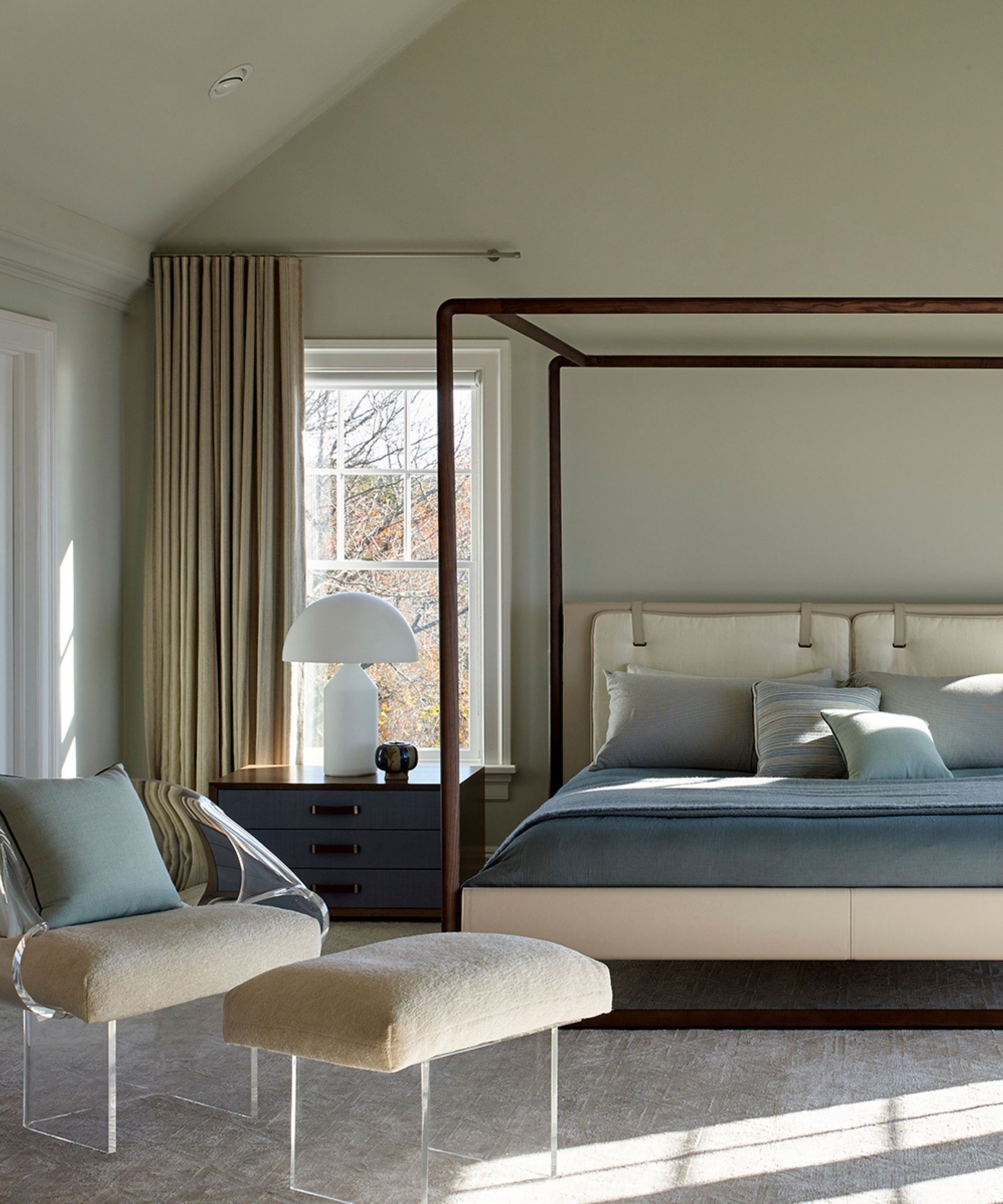
Opting for a bedroom color scheme that reflects the soothing tones of nature is a wonderful way to channel Japandi style and create a serene space to relax. Warm earthy neutrals and soft greens work well, as do myriad soft watery blues featured in this bedroom by Frampton Co.
‘Our client preferences and the landscape drove our color palette,' says Elena Frampton, principal designer and founder of Frampton Co. 'This home has expansive water views and our client loves all shades of blue. The steely blue felt ethereal, added color without detracting from a mostly neutral house, and complements the ocean beyond. The textures in the material mix contrast with the clean lines; from the rug and headboard to the custom bedside tables designed by us.’
4. Keep furniture to a minimum
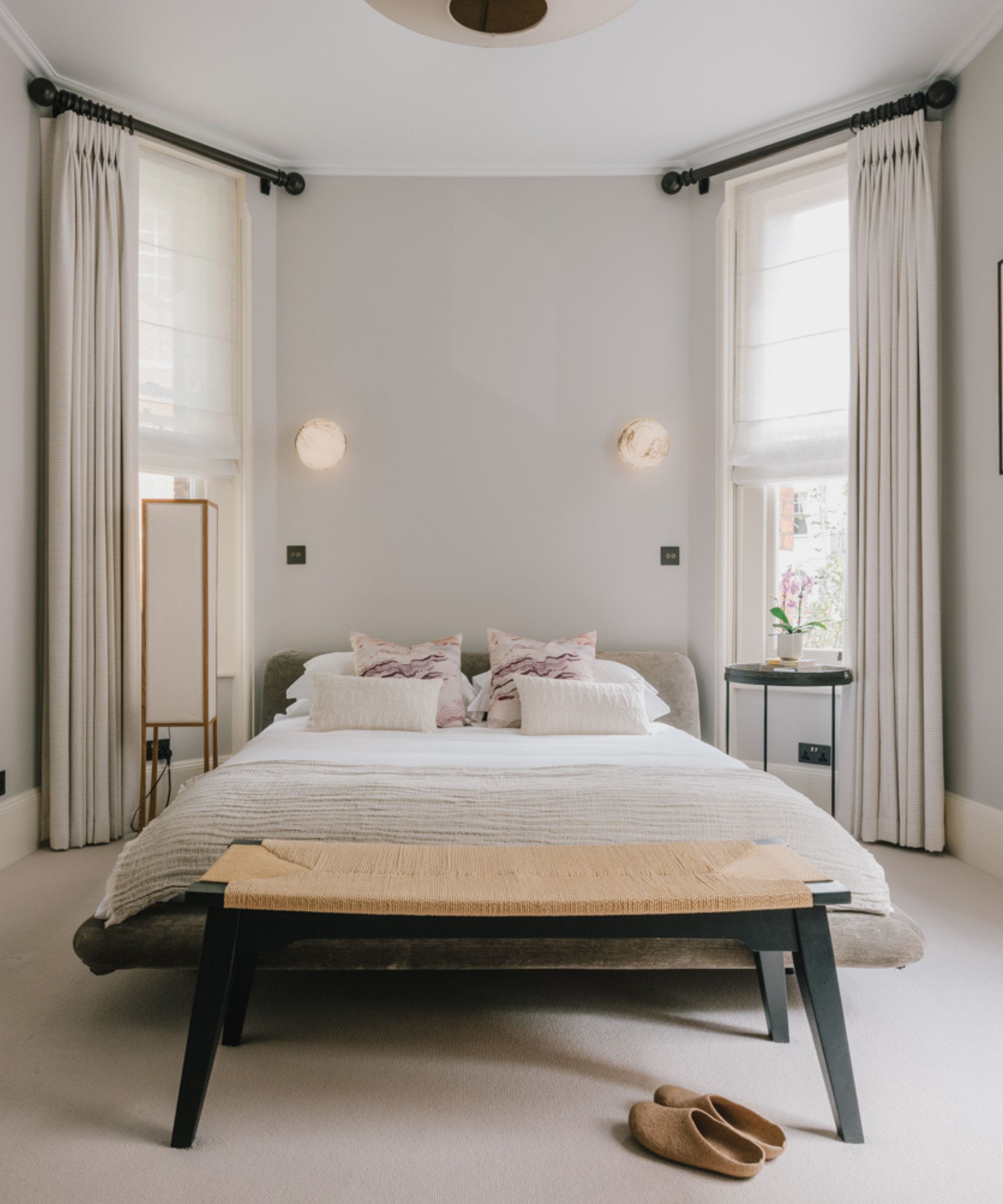
Japandi spaces are renowned for their minimalist, clutter-free look. To achieve this in a bedroom often requires having lots of hardworking storage areas elsewhere, such as a walk-in wardrobe or sleek fitted closets to allow the rest of the space to be clean, spacious and a sanctuary of calm.
In this room, interior designer Erik Munro fitted floor-to-ceiling closets to one end. Elsewhere furniture is kept to a minimum consisting of a low profile, discreet bed and a slender bedside table that keeps the space feeling open and airy.
‘To achieve the minimalist style of the Japandi look, opt for simple materials like linen curtains and wool carpets, paired with muted tonal colors to keep the space light and clean, says Erik Munro. ‘Choose key contemporary furniture pieces such as a low profile bed to nod to traditional Japanese design.’
5. Decorate with delicate patterns

Japandi bedrooms are all about creating an atmosphere of calm and well-being, but that doesn’t mean you can’t introduce touches of pattern. When it comes to fabrics or wallpapers chose delicate, flowing patterns that celebrate nature.
‘So many of our designs effortlessly embrace the tranquillity of the Japandi style through their connection to nature and the spectrum of tonal colors within the Morris & Co. palette’, says Jessica Clayworth, lead designer at Morris & Co. ‘Raw textures sit beautifully in minimal spaces, and it is a joy to layer Morris & Co. designs in these types of interiors, where nature-inspired prints juxtapose delicate, muted spaces. Marigold, the tranquil monotone design, is a joyful pattern that lifts spaces and adds interest. The symmetry of the flower head perfectly enwrapped in the fullness of its leaf creates the softest of designs, perfect for muted yet thoughtful Japandi-inspired spaces.’
6. Introduce subtle, textured wallpaper
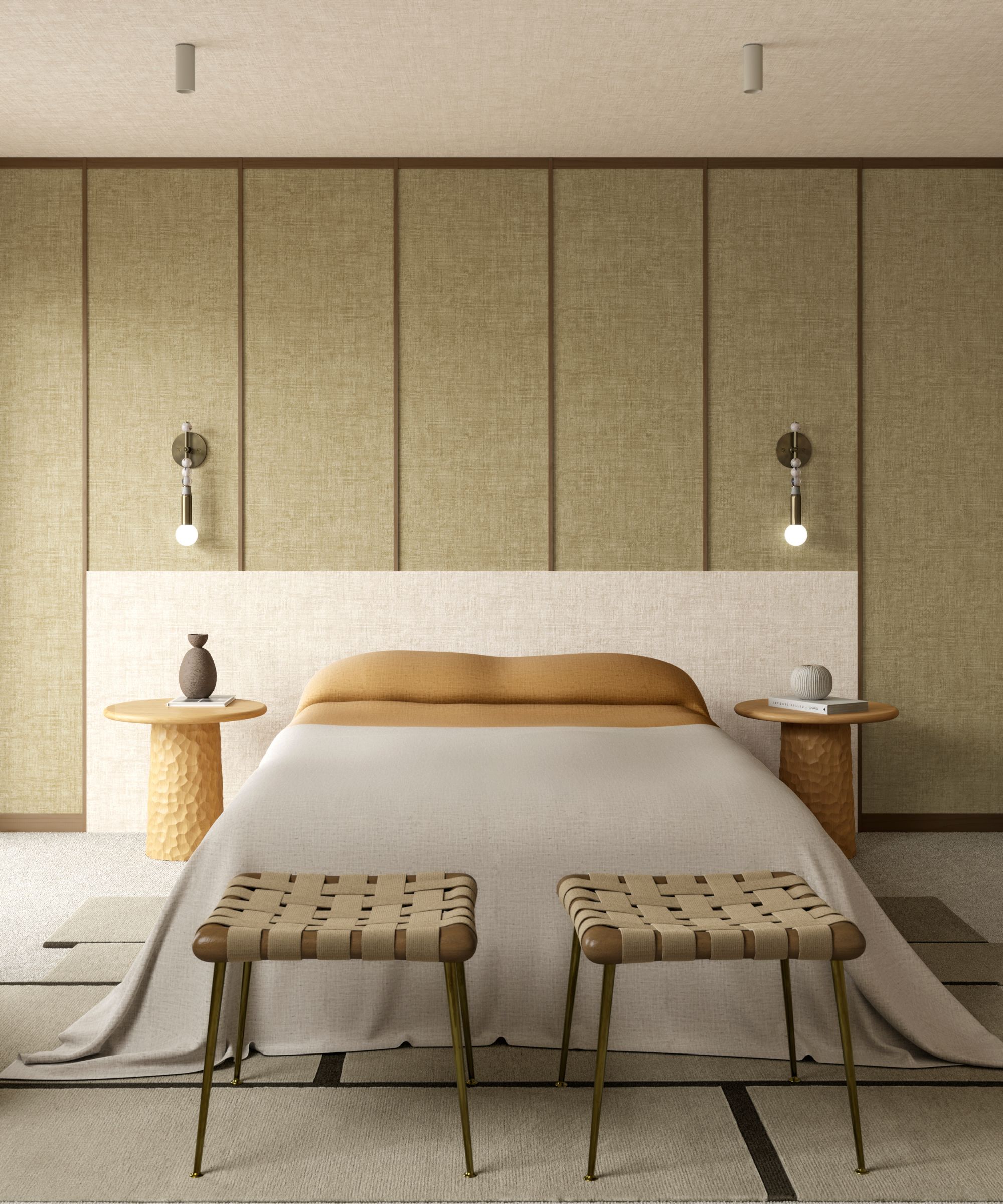
Wallpapers with subtle texture are a wonderful way to bring gentle depth and organic warmth to minimalist Japandi spaces without overpowering them.
'Whilst we have seen a lot of interest in the bolder aspects of the Japanese aesthetic in the last couple of years, the demand for more refined minimalist interiors has also been growing with the rise of the Japandi trend. There’s more appreciation for craftsmanship, natural materials, simple textures, and neutral colors, allowing for a clean design that’s simple and elegant, but still makes you feel connected to nature', says Philippe Desart, managing director at Arte.
‘It’s easy to incorporate this aesthetic into your scheme with wallpaper; choose softer, earthier tones and look for natural materials, brushed suedes, washed linens, and grasscloths to add textural interest to the space.’
7. Be clever with lighting
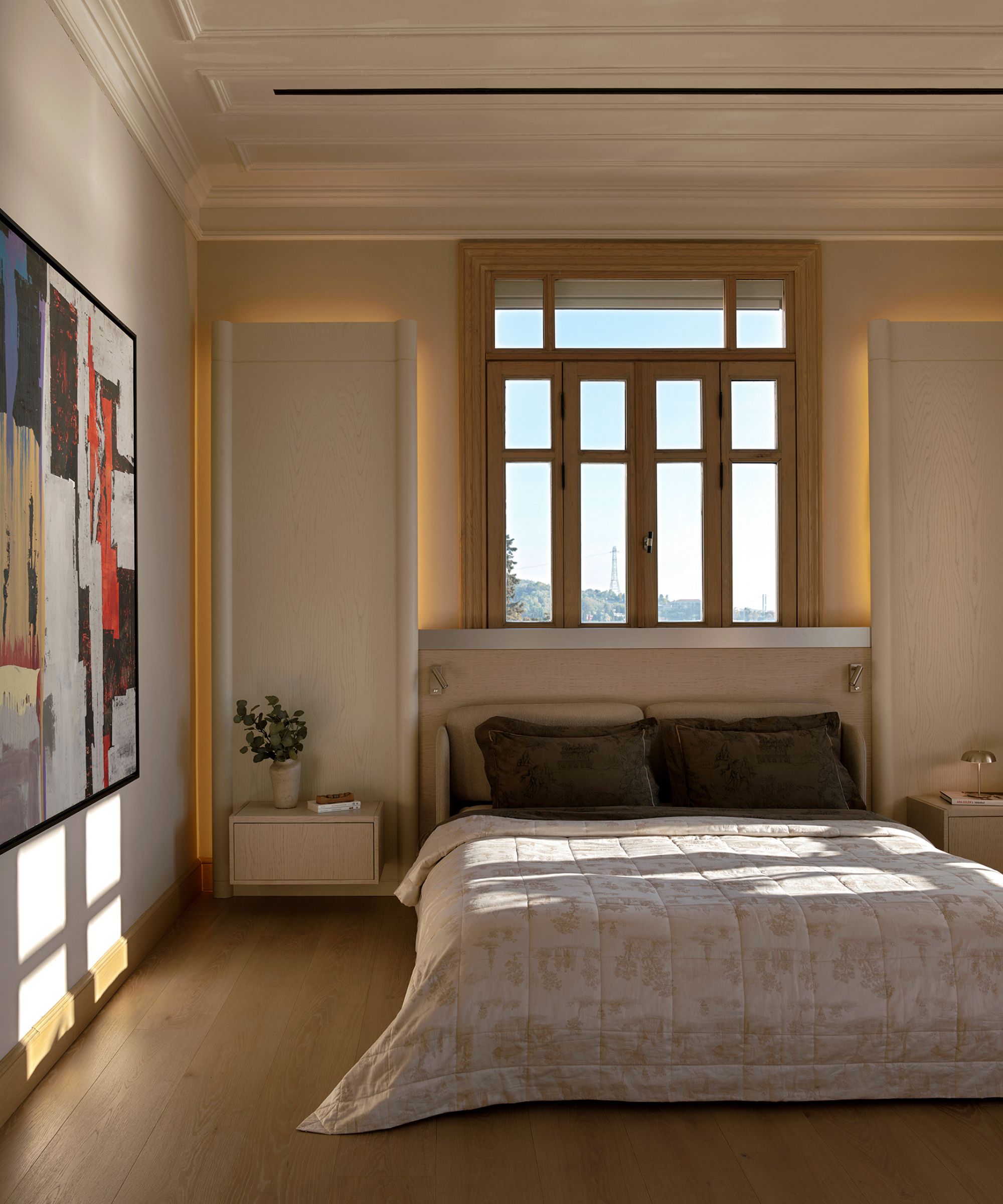
Lighting plays an important role in any bedroom. Factoring in plenty of ambient lighting is key to creating a relaxed mood. In a Japandi bedroom it’s no different, but it’s worth thinking about the style of lighting you go for. To capture a clean, minimalist look think about bedroom lighting from the outset have the room wired to allow for discreet wall light fittings.
In this interior by Escape from Sofa, ambient lighting is integrated within the architecture and set behind wall panels - this negates the need for table lamps and wires resulting in a more sleek and minimalist space.
‘Our design for 181 House prioritized natural materials like travertine marble, oak wood paneling, and linen fabrics, which respect the building’s heritage and offer an understated elegance,' say the Escape from Sofa team. 'In the bedroom, we seamlessly integrated the light fixtures into the design to further enhance the warm, serene aesthetic, creating a balanced, tranquil retreat.'
8. Embrace simple geometric shapes and straight lines
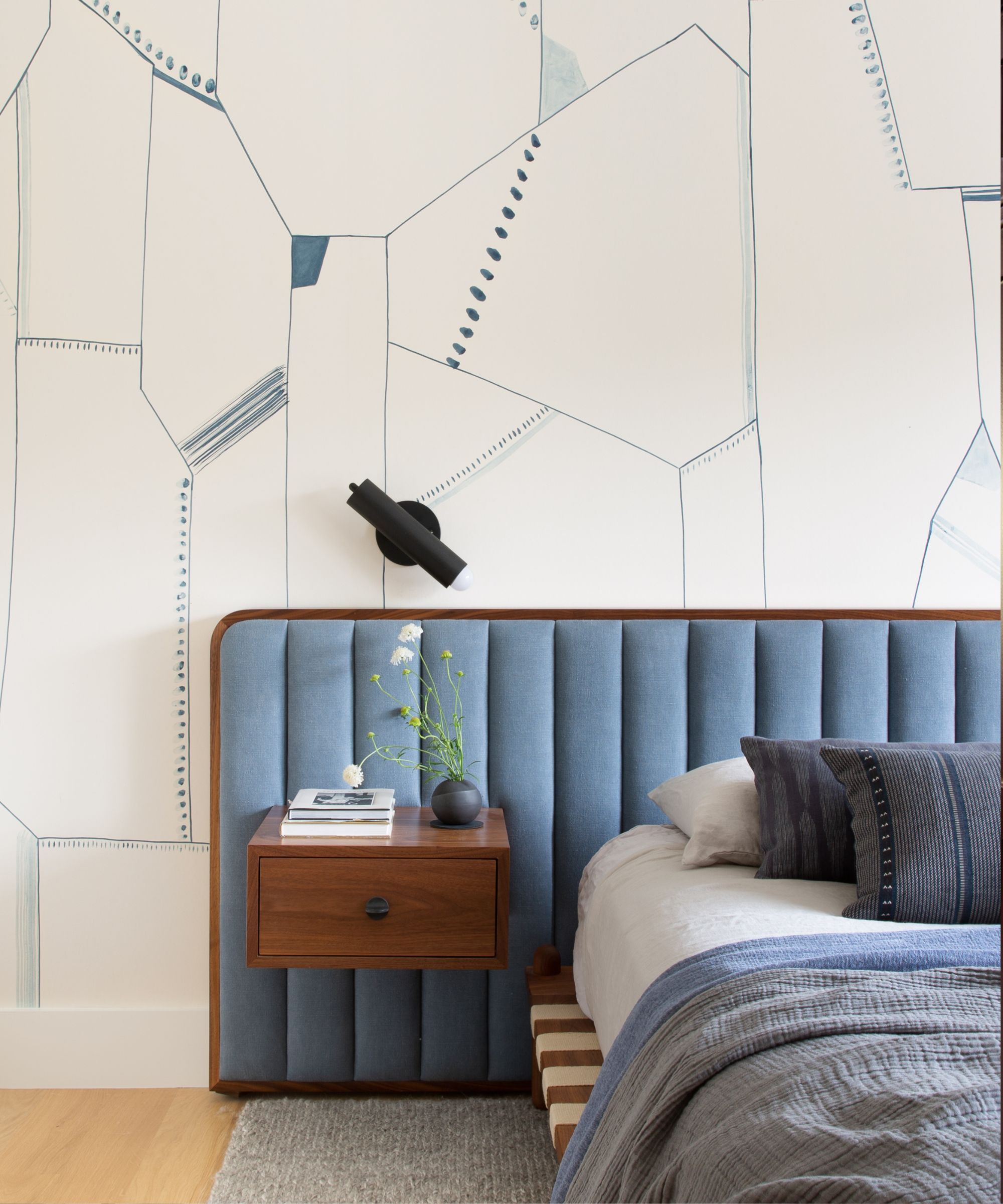
Geometry, simple shapes and straight lines feature prominently in Japandi spaces, aligning with values of simplicity and balance. Here Regan Baker paired a luxurious upholstered headboard with a chic slatted design with a low slatted bed and a gentle geometric paper to create a sophisticated scheme reminiscnet of boutique hotels with a nod to Japandi style.
'The Japandi aesthetic combines an overall simplicity with subtle yet strong details. The use of repetition and thoughtfully minimal color combinations creates an aesthetic that is calming, casual, and organic', says interior designer, Regan Baker, founder of Regan Baker Design.
‘While inspired more so by Midcentury design, the slat detailing of the headboard introduces a repetition of lines which adds a sense of structure which can be calming. This detail is also seen in the form of wood slats commonly seen in both Japanese and Scandinavian designs,’ says Regan Baker.
9. Go for a low bed

Low beds are a common feature of Japandi bedrooms. Not only do they make spaces feel more open and airy, they are also connected to ideas of well-being.
The low furniture comes from the Japanese side of Japandi. Japanese homes traditionally have tatami mat flooring, this led to a lifestyle centered close to the floor, making low furniture a natural choice. Also being close to the ground aligns with wabi-sabi, the Japanese aesthetic that values simplicity and an appreciation of the natural world. Sitting low fosters a grounded, mindful experience in daily life.,' says Laila Rietbergen. 'Many traditional Japanese activities, like tea ceremonies or dining, take place while seated on the floor. Low furniture complements these practices, blending functionality with cultural values.
Here Little Greene's Split Pink, a warm earthy pinky-brown, makes a wonderful color for bedroom walls, creating a warm and cocooning feeling.
Shop Japandi bedroom decor
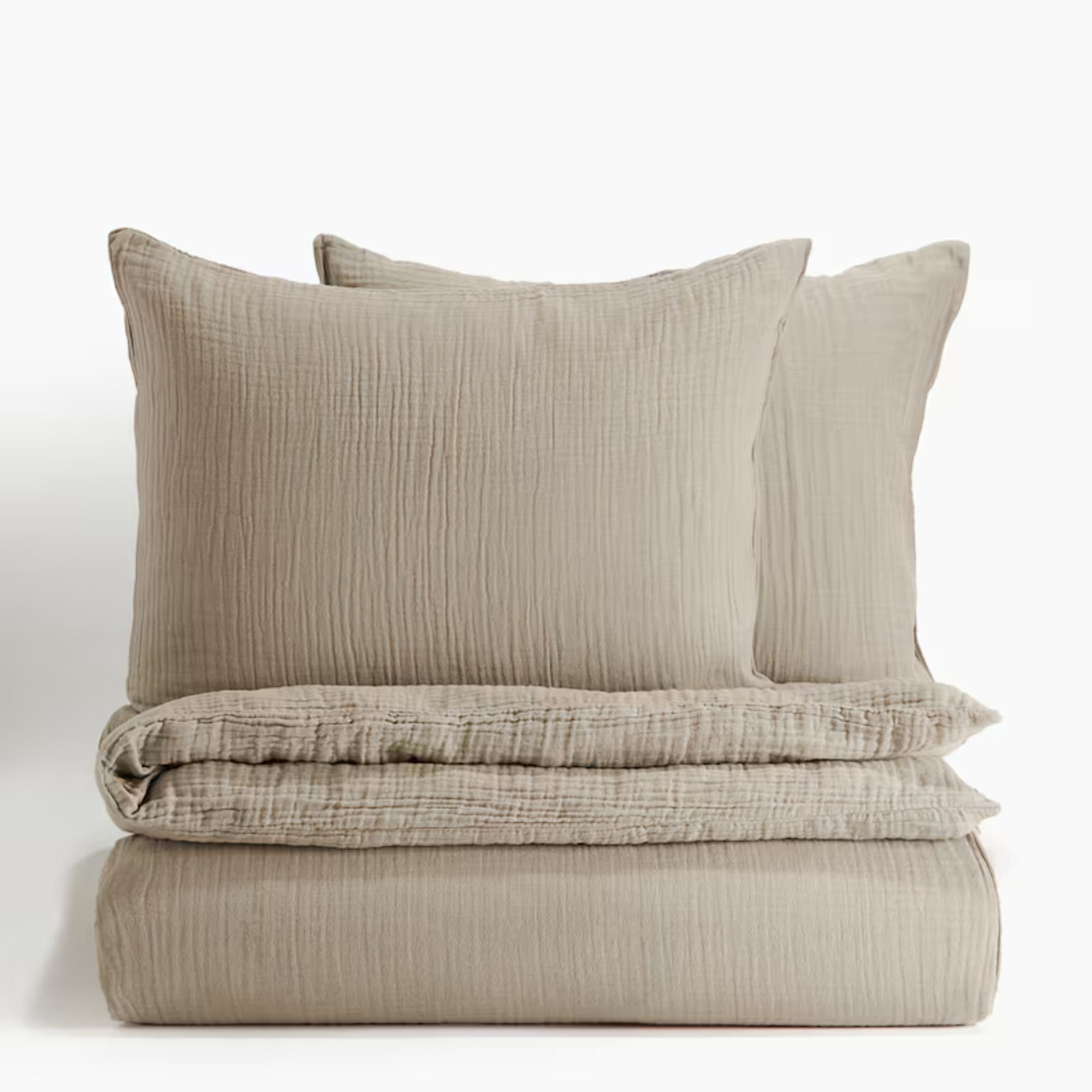
Taupe is a color you'll see a lot of in Japandi interiors. Not quite a warm tone, but not cool either it's a unique shade that keeps a space modern but welcoming. Bedding is the perfect way to bring the shade into a bedroom, and the lovely cotton muslin texture of this set is spot on for the layered look.
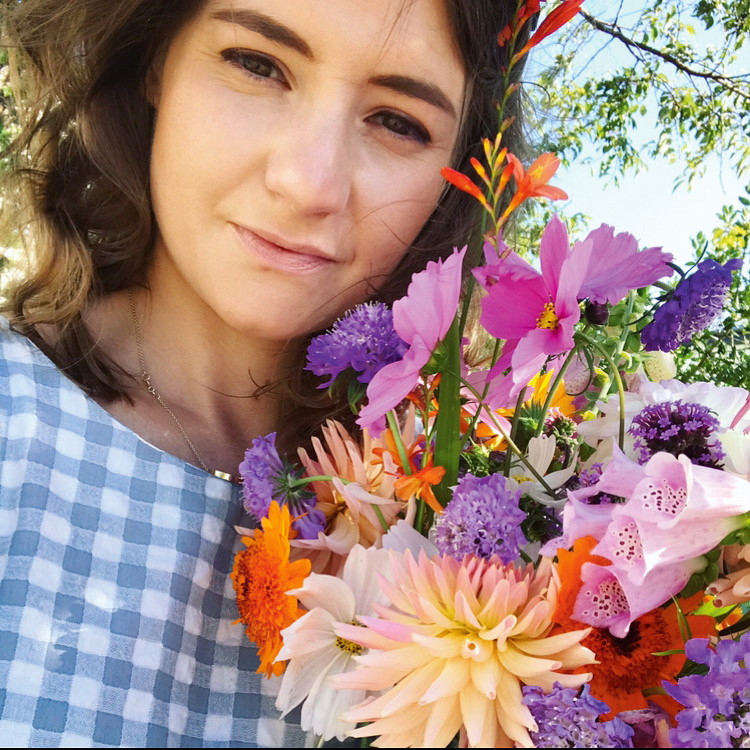
Pippa is a contributor to Homes & Gardens. A graduate of Art History and formerly Style Editor at Period Living, she is passionate about architecture, creating decorating content, interior styling and writing about craft and historic homes. She enjoys searching out beautiful images and the latest trends to share with the Homes & Gardens audience. A keen gardener, when she’s not writing, you’ll find her growing flowers on her yard for styling projects.

